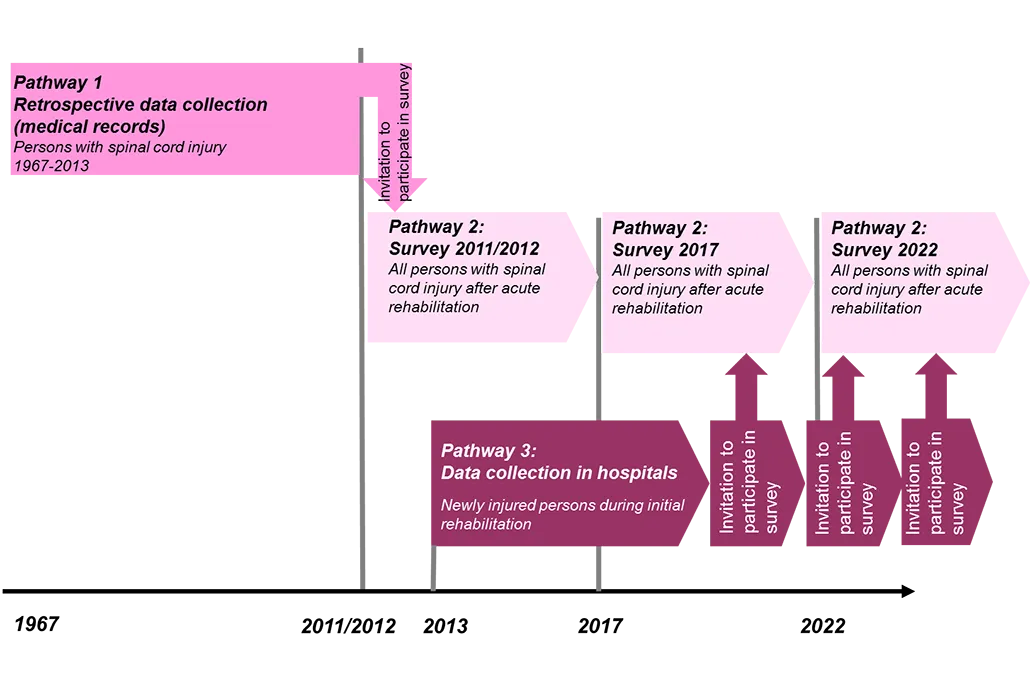Swiss Spinal Cord Injury Cohort Study (SwiSCI)
Swiss Spinal Cord Injury Cohort Study (SwiSCI) is the largest study for persons with spinal cord injuries (SCI) in Switzerland. The study investigates their life situation: From life expectancy, quality of life, physical and mental health through to mobility, gainful employment, social participation and healthcare situation.
Collaboration Partners
SwiSCI is funded by Swiss Paraplegic Foundation and carried out by Swiss Paraplegic Research. Partners are the four Swiss paraplegic centers in Nottwil, Basel, Sion and Zurich, the Swiss Paraplegic Association as well as the outpatient care association ParaHelp. Furthermore, SwiSCI closely cooperates with project groups at Swiss universities and international research institutions.
Aim
With SwiSCI, we identify problems and needs of persons with spinal cord injuries and develop approaches to optimize care. The SwiSCI results form the basis for political and healthcare decisions. As a research platform, SwiSCI enables an exchange with scientists and experts from the healthcare and social sector at national and international level.
Research Approach
SwiSCI collects long-term data: We accompany persons with SCI during acute rehabilitation in hospitals and later in everyday life. Through regular surveys, we investigate the development of health and quality of life under the influence of medical-technological progress, provision of healthcare and social changes.

Pathways
Pathway 1
Retrospective data collectionRetrospective studies are used to analyze history, based on the present situation. Within SwiSCI’s pathway 1, a retrospective data collection was carried out based on data extracted from medical records.
The survey includes persons with spinal cord injury that were injured between 1967 and 2013 and were treated in one of the Swiss paraplegic centers in Nottwil, Basel, Sion, Zurich or Geneva.
Data such as cause of injury and treatment of the spinal cord injury, comorbidities, duration of the hospital stay and socio-demographic information, e.g. age and gender, were recorded. The data also provided information about the prevalence of spinal cord injuries and life expectancy.
The retrospective SwiSCI pathway gives an overview of prevalence and development of spinal cord injuries in Switzerland in the past 50 years. This makes it possible to derive information needed for healthcare planning and to identify future development trends.
Pathway 2
Community surveyDuring the second SwiSCI pathway, we conduct a comprehensive survey among persons with spinal cord injury (SCI) in Switzerland. Thus, we collect long-term data on health and quality of life.
The survey includes questions on health, functioning, provision of assistive devices, mobility and employment.
The survey allows us to identify those areas, which are perceived as problematic by the participants of the survey – e.g. comorbidities and their treatment, return to employment or provision of assistive devices.
Based on these data, scientists can carry out in-depth research on individual topics and identify substantiated interdependencies. The aim is to improve healthcare and social services in Switzerland and to adapt them to the needs of persons with SCI. The findings are an important basis for negotiations with funding agencies and for political and legislative initiatives.
1922 persons affected by SCI participated in the first SwiSCI survey in 2012. The high number of participants provided a comprehensive picture of the current life situation, existing problems and unmet needs. The second national survey was carried out in 2017 and allowed for conclusions about development and course of SCI.
Pathway 3
Data collection in hospitalsThe third SwiSCI pathway started in 2013 and exclusively addresses newly injured persons who undergo acute rehabilitation in one of the Swiss paraplegic centers. These persons are surveyed at four predefined points in time during rehabilitation, using questionnaires and clinical tests that mainly take place during clinical treatment.
Thus, we collect information about their health situation and healthcare at an early stage of rehabilitation. The data can be used to identify factors that have a long-term influence on future life.
The results of the survey are utilized to optimize the use of interventions, therapies and assistive devices during acute rehabilitation and afterwards. This helps to support persons with SCI in achieving the highest possible degree of autonomy and the best possible quality of life.

Useful Links
Werden Sie jetzt Mitglied und erhalten Sie im Ernstfall 250 000 Franken.



